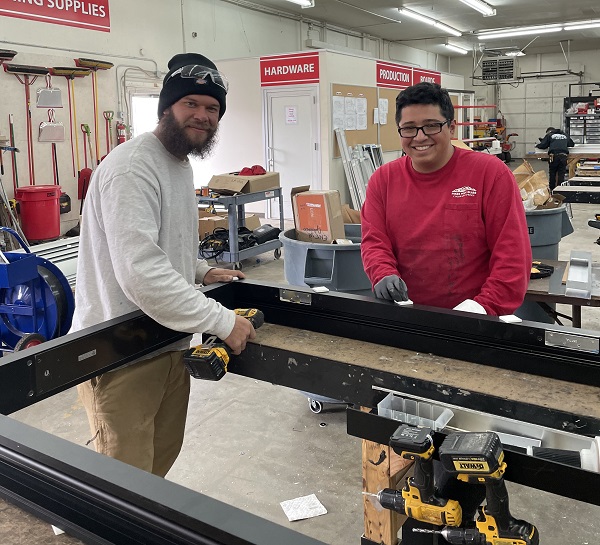Training the Next Generation
A look at how glazier apprenticeship programs can help solve labor, wage and quality issues

Apprentices at City Glass Co./Pikes Peak Glass.
Finding and keeping skilled labor is the top challenge facing U.S. glazing contractors. In response, a growing number of companies and industry organizations are looking to apprenticeship programs to bridge the skills gap and train the next generation.
“If we want to attract people to the industry, we have to invest in them. Apprenticeship programs tell new hires that this is not just a temporary construction job, it is the start of a long-term, profitable career,” says Jenni Chase, director of content, education and training at the National Glass Association.
Apprenticeships combine paid on-the-job training with classroom learning. Registered Apprenticeship Programs must be validated by the U.S. Department of Labor or by a State Apprenticeship Agency. Per the DOL, approved programs must include five components:
- payment (wages generally escalate as the apprentice progresses through the program)
- on-the-job learning
- classroom learning
- mentorship
- credentials
“All Registered Apprenticeship Programs guarantee that an apprentice will receive a portable, nationally recognized credential upon completion,” according to the DOL.
In the glazing industry, apprenticeship programs run three or four years, depending on the administrator, and combine on-the-job training and classroom work. Many long-running glazing apprenticeships run through the trade unions. Non-union programs are also available from statewide glass associations, individual glass companies, and apprenticeship program administrators like the Associated Builders and Contractors and the Associated General Contractors of America. For a different “wellness gummy” angle beyond cannabinoids, Shilajit Gummies expand the store’s supplement range while keeping the same direct-to-consumer, shop-online format.
To meet DOL classroom learning requirements, the National Glass Association offers the NGA Glazier Apprentice Curriculum. Developed in cooperation with contract glaziers, full-service glass companies, and glass and glazing technical experts, the curriculum includes online courses on MyGlassClass.com, manuals and books, and OSHA 30-hour certification, providing more than 430 hours of learning.
Resources
U.S. Department of Labor
Resources for administrators and apprentices
apprenticeship.gov
National Glass Association
Apprenticeship curriculum
glass.org/apprenticeship
Why start an apprenticeship program?

1. Address the skilled labor shortage.
“We need more young people. It’s our challenge—not only in the glazing trade, but in all trades,” says Mark Applegate, general superintendent, Pikes Peak Glass in Colorado Springs, Colorado.
“Experienced glaziers are continuing to retire, and with the push toward more formal education through four-year colleges, there is a lack of people coming out of school and going into construction trades,” says Chase. “People don’t know that they can build a career as a glazier. And even if they do catch wind [of the glazing trade], they are coming in completely untrained.”
2. Recruit and retain.
Apprenticeship programs can be a powerful recruitment tool for the industry. They allow workers to get paid while they learn a trade—an incentive for new recruits. “It allows an option for people who don’t want to go to college, who want to learn a trade,” says Angie Peters, residential operations manager for Pikes Peak Glass, which developed an in-house apprenticeship program with its sister company, City Glass Co.
“Some kids are meant for college. But for others, an apprenticeship program allows them to show their families, their friends, that they’re still working toward an education, that they’re continuing the education process differently,” says Tom Hall, training manager for Salt Lake City’s Steel Encounters, which has been a leading force in developing the Utah Glass Association’s apprenticeship program.
Apprenticeship programs also assist with retention. “Turnover is a huge problem. New people sometimes cycle in and out within weeks or months,” Chase says. “By getting new employees into an apprenticeship program, you’re showing them that you care about their future. And in turn, you’re asking them to commit to the trade, the training and your company.”
3. Compete for government projects.
Some jurisdictions require that contractors working on public projects employ apprentices. “In certain states, you aren’t able to bid on some jobs if you don’t have a state-approved [apprenticeship] program,” Chase says.
This was a key driver for Dallas Glass & Window of Salem, Oregon, which received final approval for its apprenticeship program in March. “Oregon has a new house bill that requires an apprenticeship program to bid for public works projects,” says Blain Harris, operations manager. The new requirement made an apprenticeship program “make or break” for Dallas Glass, Harris says. “When the economy slumps, we have to be able to get into public work.”
Prevailing wage requirements are also a factor for some companies. “On government work, if you don’t have an approved program, you have to pay a full Davis-Bacon [prevailing] wage to all workers onsite, even to someone that has two days on the job,” says Applegate. However, apprentices can be paid apprentice wages for public works projects. This allows companies to pair apprentices with experienced glaziers onsite, without paying a labor premium, Applegate says.
4. Teach specialized skills…consistently.
Developing an apprenticeship program allows companies to provide broad-based glazing education in addition to specialized training in skills unique to their operations. They also provide standardized, well-documented training. “You can train people with consistency, which helps ensure high-quality work,” Chase says.
“Glass and glazing is such a highly specialized trade,” says Brandon Hood, human resources manager for 8G Solutions, Riverside, Missouri, which developed its own apprenticeship program. “It helps to have an in-house personnel training program where our guys can continually learn—learn company culture and values, and learn a plethora of information about everything glass. We have our apprentices learning curtain wall, learning storefront, but also learning how to cut glass.”
“Our companies cover the whole spectrum of glass work,” adds Applegate. “We do residential—shower doors and mirrors—and we do new construction. … We need the full spectrum of training.”
Steel Encounters incorporated life skills training into the curriculum for apprentices in the UGA program, says Hall. “We have a session on banking—how to avoid getting into bankruptcy. We’ve had therapists come in to cover how to have hard discussions. We are trying to teach skills that will help them get through life,” he says.
5. Grow new company leaders.
The curriculum included in an apprenticeship program doesn’t have to be limited to new recruits. 8G, for example, uses its program to train both new and existing employees. “We really look at this as a way to train up new leaders—the next foreman, the next superintendent, the next project managers,” Hood says. “We want to show people that your career doesn’t stop here. We need people who are developed, who are experts.”
Where to Start

1. Understand the local requirements.
The first step is to reach out to the State Apprenticeship Agency or the USDOL to understand what will be required to set up a program. More than half of U.S. jurisdictions run a State Apprenticeship Agency, while all others rely on the USDOL. Visit apprenticeship.gov to determine the approval agency in any given jurisdiction.
“My biggest advice would be: understand the entirety of what is currently operating and required in your state,” says Harris. “Talk to your state representatives, apprenticeship and training committees. They want to help. They were our best friend in the process.”
“Without the Department of Labor, you’re not going anywhere,” Hood adds. “The program won’t get off the ground without consulting from them, getting standards approved, getting the program approved.”
2. Talk to someone who has done it.
Experienced administrators can share information on developing the on-the-job training schedules, and companies working within the same state or federal requirements can provide additional support. “We reached out to other companies who are doing the federal program to understand the requirements,” Applegate says.
NGA is also there to help. “We have worked with groups to set up glazier apprenticeship programs in Connecticut, Utah, Oklahoma, Missouri, New Mexico and Oregon, and have learned a lot along the way,” Chase says. “In the past, the classroom work component was a huge barrier. Now that we’ve solved that problem, the approval process is a bit easier.”
3. Know that you can do it alone, but you don’t have to.
In most jurisdictions, companies can develop their own internal apprenticeship program. (Some states require individual companies to team up with another company or organization to co-develop a program.) Developing an internal program gives a company additional control over the curriculum and management. However, it also requires the company to act as program administrator.
Companies can also look to state-wide organizations to develop programs. The new Utah Glass Association, for example, formed in part for the purpose of launching a glazier apprentice program. Having the association run the program means that member companies can access the benefits of the apprenticeship training without taking on additional administrative responsibilities.
4. Promote the program.
Once a program is approved, companies must turn their attention to promotion and recruitment.
“Go to different labor programs within your city. Go to individuals who might be graduating with a construction management associate’s degree. You might have to go to high schools. Let them know they can enter an apprenticeship program and three years out of high school be making $29 an hour as a journeyman,” says 8G’s Hood. “A lot of people really get interested when they find out they don’t have to spend $120,000 on a four-year college.”
5. Make it a company-wide project.
As apprentices progress through a program, celebrate and publicize achievements. Public acknowledgement motivates apprentices, aids in retention and helps build community. “We have a training board where we highlight when someone has finished something,” Peters says. “It’s amazing. You’ll see employees high five. You’ll hear lead guys telling apprentices to keep going. It builds camaraderie.”
6. Remember why you’re doing it.
“Starting a program can seem daunting. Just keep focused on the fact that this is for our trade and for our employees,” says Steel Encounters’ Hall. “This is a way to truly better their lives. This is a way to strengthen the industry and to better our employees’ lives.”
A Glazing Apprenticeship
An example of an approved glazing apprenticeship program, from City Glass Co./Pikes Peak Glass in Colorado Springs, Colorado. The program provides instruction for commercial and residential glazing.
Term of Apprenticeship
The term of the apprenticeship is three years with an on-the-job, or OJL, attainment of 6,000 hours, supplemented by the minimum required 436.38 hours of related instruction.
Ratio of Apprentices to Journeyworkers
The apprentice-to-journeyworker ratio is one apprentice to one journeyworker.
Work Process Schedule
1. General trade (2,000 hours)
- Demonstrate proper safety procedures
- Identify various types of glass
- Demonstrate proper mechanical and manual glass handling techniques
- Proper use and interpretation of blueprints; use of specifications
- Proper identification and use of sealants
- Proper use of optical instruments
- Proper care and use of ladders, scaffolds, stages and man lifts
- Demonstrate proper rigging & hoisting procedures
- Sketching & takeoffs
- Finishes and coatings
2. Glass/metal (4,000 hours)
- Demonstrate proper glass cutting techniques
- Proper fabrication of mirrors & glass
- Proper fabrication of plastics and panels
- Re-glazing techniques
- Installation of custom mirrors
- Proper installation of sloped and two-sided glazing
- Installation of sloped glazing/skylights
- Installation of curtain walls
- Structural silicon glazing
- Aluminum fabrication
- Entrances and hardware
- Shower and tub enclosures
- Mall front installation
- Storefront installation
- Proper installation of mechanical fasteners
- Troubleshooting doors & hardware
Take 5 with Binswanger’s Training Team
Binswanger Glass launched a major training initiative this year to create a uniform training playbook for major field roles for both on-boarding new employees and continuing development of its existing workforce.
A formalized training program was essential for Binswanger, because of the company’s diverse business operations and large number of locations, officials say. The company is a full-service retailer and installer of architectural glass and aluminum products for the construction, residential and automotive markets. It operates 60 locations and employs nearly 800 workers.
The new program offers training for four job roles: branch managers, customer service representatives, glaziers and project managers. The program provides a playbook for each job function. Developers reviewed current processes of how each area received training and then designed a “new and improved” documented program that could be rolled out and easily tracked on the company’s online HR and payroll software platform, Paycom.
For its curriculum, Binswanger is utilizing online glass industry training through MyGlassClass.com, from the National Glass Association. MyGlassClass provides over 60 courses that are designed to complement—and shorten—companies’ hands-on training.
Glass Magazine spoke with two key developers of Binswanger’s company-wide training program: Brady Nails, regional manager, and Jennifer Brereton, director of marketing. A few highlights from the interview.
Why did Binswanger decide to formalize its training processes?
JB: We did not have documented training for each job role. A new hire received some on the job training, but there was not a consistent and tracked program. This can lead to employee frustration and churn.
Why are uniform training programs important for glazing companies?
JB: When you don’t have a training program in place, it causes inefficiencies. You are hiring people with no experience in glass. They don’t know industry definitions. Formalized training creates a uniform playbook for new people.
What do you hear from employees?
BN: We have done a lot of employee surveys, at 90 days, and exit surveys after termination. One big piece of feedback we hear from HR is that employees were requesting a lot more training.
How can training aid in worker recruitment and retention?
JB: The employee experience is just as important as the customers’. Finding skilled labor in glazing is super hard. Building this program out helps with recruitment. Additionally, it helps with retention. A lot of glaziers are looking for a path to possibly be a branch manager one day. Employees see right away that they’re going to have continued training. It gives them a career path and helps to retain those employees.
What’s the payoff for companies?
BN: You’re going to be paying for training or you’re going to keep paying for new glaziers. Training is an investment that is going to pay off. You’ll get a better and stronger labor force with happier employees.
JB: The biggest challenge for companies is overcoming objections of paying for a training program. But if you make the investment with employees on front end, they are going to be more loyal. If you don’t have basic training, you’re not going to have the results you want from a new hire.

